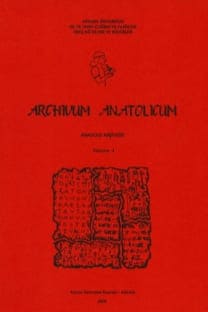Eski Mezopotamya’da Kadınların Diplomasideki Rolü Bağlamında Mari Kraliçesi Šibtu’nun Yazışmalarından Örnekler
Mari mektupları, Mari sarayı, Zimri-Lim, Harem
The Examples of Correspondences of Šibtu, the Queen of Mari, in the Context of the Role of the Women in Diplomacy in Ancient Mesopotamia
Mari Letters, Palace of Mari, Zimri-Lim, Harem,
___
Abrahami, Philippe “La circulation militaire dans les textes de Mari: La question des effectifs” In La Circulation Des Biens, Des Personnes Et Des İdees Dans Le Proche-Orient Ancien, ed. D. Charpin and F Joannes. Actes de la XXXVIIIe Rencontre Assyriologique Internationale, Paris, 8-10 Juillet-Paris 1991, 157-166.Adams, Robert. Mc. “The Study of Ancient Mesopotamian Settlement Patterns and the Problem of Urban Origins”, Sumer 25, (1969): 114-124.
Artzi, Pinhans-Malamat, Avraham. “The Correspondence of Šibtu, Queen of Mari in ARM X”, Orientalia, Nova Series, Vol. 40, No. 1 (1971): 75-89.
Buccellati, Giorgio. The Amorites of the Ur III Period, Istituto Orientale di Napoli, 1966.
Charpin, Dominique. “Patron and Client: Zimri-Lim and Asqudum The Diviner”, The Oxford Handbook of the Cuneiform Culture,ed. Karen Radner-Elanor Rabson, Oxford University Press. 2011, 248-309.
Coleson, Joseph. Yaqqim-Addu of Sagaratum: The Correspondence of a District Governor in the Kingdom of Mari, Brandeis University, 1982.
Dalley, Stephanie, Mari and Karana: Two Old Babylonian Cities, Longman-London. 1984.
Dossin, Georges. “Šibtu, reine de Mari” in Actes du XXI. Congrès International des Orientalistes, Paris (1949): 142-143.
Dossin, Georges. Correspondance de Šamši-Addu Et De Ses Fils, İmpbimerie Nationale-Paris, 1951.
Dossin, Georges-André Finet. Correspondence Feminine ARM 10, Geuthner Paris 1946/1978.
Durand-Jean-Marie- Margueron, Jean. “La Question du Harem Royal dans le Palais de Mari”, Journal des Savants 4 (1980): 253-263.
Durand, Jean-Marie. “Trois tudes sur Mari”, Mari 3 (1984): 127-79.
Durand 1985: J.M. Durand, “Les dames du palais de Mari”, Mari 4 (1985): 385-436.
Gates, Marie-Henriette. “The Palace of Zimri-Lim at Mari”, The Biblical Archaeologist, Vol. 47-2 (1984): 70-87.
Gelb, Ignace, J. “An Old Babylonian List of Amorites”, JAOS 88 (1968): 36-46.
Heimpel, Wolfgang. Letters to the King of Mari: A New Translation, with Historical Introduction, Notes and Commentary, Eisenbrauns USA- 2003.
Heintz, Jean-Georges. Prophétisme et Alliance: Des Archives royales de Mari à la Bible Hébraïque, Fribourg / Göttingen: Academic Press Zurich Open Repository and Archive, 2015.
Khurt, Amelie. Eskiçağda Yakındoğu, Cilt I, (Türkiye İş Bankası Yayınları) İstanbul, 2009.
Köroğlu, Kemalettin. Eski Mezopotamya Tarihi Başlangıçtan Perslere Kadar, İletişim Yayınları, 2016.
Kupper, Jean-Robert, Archives Royales de Mari XXII/I, Documents Administratifs de la Salle 135 du Palais de Mari, 1. cilt, Éditions Recherche sur les Civilisations, 1983.
Lafont, Bertrand. “Mari Sarayındaki Kadınlar”, Eski Yakındoğu Sumer’den Kutsal Kitap’a, edt. Jean Bottero, çev. Adnan Kahiloğulları, Pınar Güzelyürek, Lale Arslan Özcan, Dost Kitabevi-2005, 139-150.
Lemaire, Andre. “Mari, The Bible and The Nortwest Semitic World”, BA 47 (1984): 101-108.
Malamat, Avraham. Mari and the Bible, Brill-Leiden, 1998.
Merlo, Paolo. “āpilum ša Mari”, Ugarit-Forschungen 36 (2004): 321-331.
Michalowski, Piotr. “Foreign Tribute to Sumer During The Ur III Period”, ZANF 68 (1978): 34-49.
Nissinen, Martti-Ritner, Robert- Choon-Leong Seow. Prophets and Prophecy in the Ancient Near East, Social Biblical Literature-Atlanta 2003.
Oates, Joan. Babil, Arkadaş Yayınları, Ankara 2004.
Parrot, André. Mission archéologique de Mari, Vol. II., Geuther-Paris 1959.
Sasson, Jack M. “Biographical Notices on Some Royal Ladies from Mari”, Journal of Cuneiform Studies, Vol. 25, No. 2 Apr. (1973): 59-78.
Sasson, Jack M. “Two Recent Works on Mari”, Archiv für Orientforschung, 27. Bd. (1980): 127-135.
Sasson, Jack M. “Mari Dreams”, JAOS 103 (1983): 291-297.
Sasson, Jack M. “Thoughts of Zimri-lim”, Biblical Archaelogist, No: 2-June (1984): 110-120.
Sasson, Jack M. “The King and A Mari King in Changing Perceptions”, Journal of the American Oriental Society, , 118/4 (1998): 543–570.
Sasson, Jack M. “On Reading The Diplomatic Letters in The Mari Archives”, Amurru 2 (2001): 329-338.
Ziegler, Nele. La population féminine des palais d'apres les Archives Royales de Mari: Le Harem de Zimrî-Lîm Florilegium Marianum IV, Mémoires de NABU 5; Paris: SÉPOA, 1999.
Ziegler, Nele. Les Musiciens Et La Musique D'apr˙s Les Archives De Mari, Florilegium Marianum IX, Mémoires de NABU 10; Paris: SÉPOA, 2007.
Ziegler, Nele. “Economic Activities of Women According to Mari Texts (18th Century BC)”, The Role of Woman in Work and Society in the Ancient Near East, edt. Cecile Michel-Brigitte Lion, Walter de Gruyter 2016, 298-309.
Veenhof, Klaas R. Aspects of Old Assyrian Trade and Its Terminology, Leiden Brill 1972.
AHw: Akkadisches Handwörterbuch – Wiesbaden 1958-1981.
ARM: Archives Royales de Mari-Paris.
ARM 10: G. Dossin-A. Finet, Archives Royales de Mari X, Correspondence Feminine, Paris 1967.
CAD: The Assyrian Dictionary of the Oriental Institute of the University of Chicago – Chicago 1956vd.
CDA: J. Black, A. George, N. Postgate, A Concise Dictionary Of Akkadian, Harratzowitz Verlag 2000.
- ISSN: 1300-6355
- Yayın Aralığı: Yılda 2 Sayı
- Başlangıç: 1995
- Yayıncı: Ankara Üniversitesi
Eski Asurca Kaynaklara Göre Asur-Anadolu İlişkilerinde Hahhum Krallığı’nın Önemi
Soranus’ Text “On Signs of Fractures”
Kültepe’den Değişik Bir Ticari Mal Listesi (Kt n/k 1697)
Eski Asurca Metinlerde Anadolu Köprüleri
Yeni Asur Emperyalizminin Bir Sonucu Olarak İsyanlar
Asur Ticaret Kolonileri Dönemi'nde Nafaka Ödeniyor muydu?
